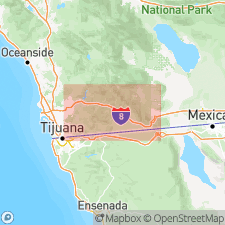
- Usage in publication:
-
- Ballena gravel
- Modifications:
-
- Original reference
- Dominant lithology:
-
- Lava
- Quartzite
- Schist
- AAPG geologic province:
-
- Capistrano basin
Summary:
Pg. 1556-1561. Ballena gravel (or conglomerate) has been cause of considerable discussion and has been differently interpreted. It has an important bearing on geomorphologic history of Peninsular Range. Was first described [but not named] by H.W. Fairbanks (California State Min. Bur. Ann. Rpt., 1893, no. 11, p. 91-92). [Fairbanks named the whaleback-shaped hill but not the deposit.] Occurs in 10 or more areas, extending southwest from near Witch Creek (at 3,000 feet) to southwest of Ballena (at 2,400 feet), and west to San Vicente Valley (at 2,000 feet) in Ramona quadrangle to west and northwest of Padre Barona Valley (at 1,800+/- feet) in Cuyamaca quadrangle. The largest area, several miles long is southwest of Ballena, [Ramona quadrangle, San Diego County, southeastern California], where the gravel caps ridges 300 to 500 feet high. This may be regarded as type locality. All the areas were doubtless once continuous. Consists largely of pebbles and boulders of red and gray porphyritic lava, considerable quartzite, and some schist. Thickness 100 feet or more. Striking similarity between the pebbles and boulders of Ballena gravel and Poway conglomerate (marine) strongly indicates their former continuity. [Age is] late Eocene. Deposited locally. Probably = Poway conglomerate.
Source: US geologic names lexicon (USGS Bull. 896, p. 106).
For more information, please contact Nancy Stamm, Geologic Names Committee Secretary.
Asterisk (*) indicates published by U.S. Geological Survey authors.
"No current usage" (†) implies that a name has been abandoned or has fallen into disuse. Former usage and, if known, replacement name given in parentheses ( ).
Slash (/) indicates name conflicts with nomenclatural guidelines (CSN, 1933; ACSN, 1961, 1970; NACSN, 1983, 2005, 2021). May be explained within brackets ([ ]).

